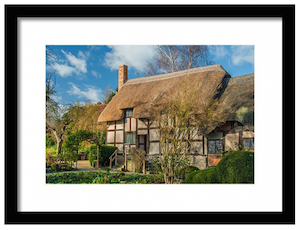
The Chichester Market Cross is perhaps the finest surviving example of medieval market cross in Britain. This ornately decorated octagonal stone structure dates to the early years of the 16th century but it stands on the site of a much older timber-framed building that stood here since the middle of the 14th century.
History
Sometime during the bishopric of Bishop Rede, who served from 1369-1385, a timber market cross was erected at the meeting place of the four main streets of the medieval city, close to the line of the original Roman roads
In 1501 the Bishop of Chichester, Edward Story, paid ten pounds to the Mayor of Chichester for the plot of land where the 14th-century cross stood. Here he erected a new market cross in stone to serve as a focus for local merchants to sell their goods. Bishop Story allowed poor peasants to use the market cross without paying a fee on the provision that they stand under the cross.
When Bishop Story died in 1503, he left twenty-five pounds a year to pay for maintenance of the market cross in perpetuity.
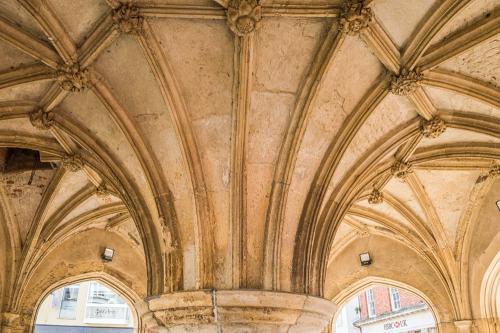
The Cross
The 16th-century market cross was built of Caen stone, highly prised by masons for its durability. It is designed around a central stone pillar braced by eight flying buttresses. Stone seats are arranged around the base of the central pillar and the floor of the cross is paved with stone. Each of the eight faces of the cross are decorated with bosses depicting demi-angels and a Bishop's mitre.
In 1724, Lady Farrington paid for three clocks to be installed along with a plaque to mark the gift. Having only three clocks proved unpopular, so in 1746 the 2nd Duke of Richmond had Lady Farrington's clocks removed and four new clocks installed. These are the clocks we see today, each aligned to one of the four cardinal points of the compass.
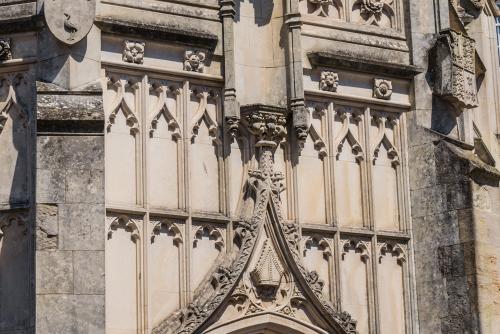
The market cross fulfilled its function for over three centuries, but by the turn of the 19th century the growing city had become too large and prosperous for the medieval building and it ceased to be used for a market in 1808 when the Butter Market was built on North Street.
The market cross narrowly escaped destruction after the new market house was built. Since the medieval cross was no longer needed to act as a market place, it was proposed to pull it down since it was deemed a traffic obstruction. Local residents bought several houses north of the market cross and had them destroyed, creating more space for traffic and avoiding the need to tear down the market cross.
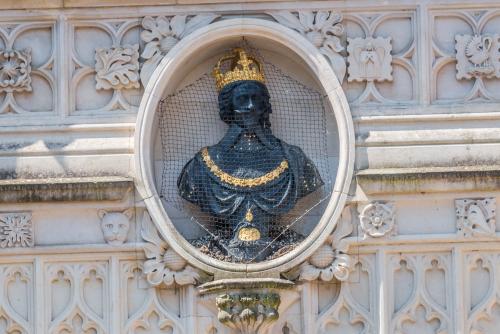
King Charles I Bust
In 1664 a bust of King Charles I was presented to the City of Chichester in gratitude for the city's support of the Royalist cause during the Civil War.
One has to wonder if Charles II had his tongue firmly planted in his cheek when he thanked the city for its loyalty to his cause, because the MP for Chichester, William Crawley, signed King Charles I's death warrant. When Charles II was restored to the throne in 1660, Crawley fled abroad, fearing retribution for his role in executing the new king's father. He lived in exile for the rest of his life.
Chichester's city government decided that they needed to make a statement to assure the new king that they were firmly behind him, so they had the bust put up in perhaps the most prominent place in Chichester.
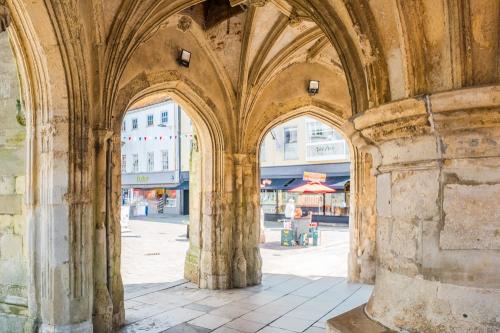
This bust was sculpted by Hubert Le Sueur, a French sculptor at the court of King Louis XIII who spent much of his career at King Charles I's court. The bust we see today is a fibreglass replica, and the original is preserved at the Novium Museum, a short stroll from the market cross.
Visiting
The Market Cross stands at the junction of East Street, West Street, North Street, and South Street, in the very heart of Chichester. It is accessible at any time.
About Chichester Market Cross
Address: South Street,
Chichester,
West Sussex,
England, PO19 1QD
Attraction Type: Historic Building
Location
map
OS: SU860048
Photo Credit: David Ross and Britain Express
POPULAR POSTS
HERITAGE
 We've 'tagged' this attraction information to help you find related historic attractions and learn more about major time periods mentioned.
We've 'tagged' this attraction information to help you find related historic attractions and learn more about major time periods mentioned.
Find other attractions tagged with:
NEARBY HISTORIC ATTRACTIONS
Heritage Rated from 1- 5 (low to exceptional) on historic interest
Chichester, St Olave's Church - 0 miles (Historic Church) ![]()
Chichester Council House - 0.1 miles (Historic Building) ![]()
Pallant House Gallery - 0.1 miles (Museum) ![]()
Chichester Roman City Walls - 0.1 miles (Roman Site) ![]()
Canon Gate - 0.1 miles (Historic Building) ![]()
Chichester Cathedral - 0.1 miles (Cathedral) ![]()
Chichester, St Peter the Great Church - 0.1 miles (Historic Church) ![]()
The Novium Museum - 0.1 miles (Museum) ![]()
Nearest Holiday Cottages to Chichester Market Cross:
Runcton, West Sussex
Sleeps: 4
Stay from: £491 - 1517
More self catering near Chichester Market Cross



